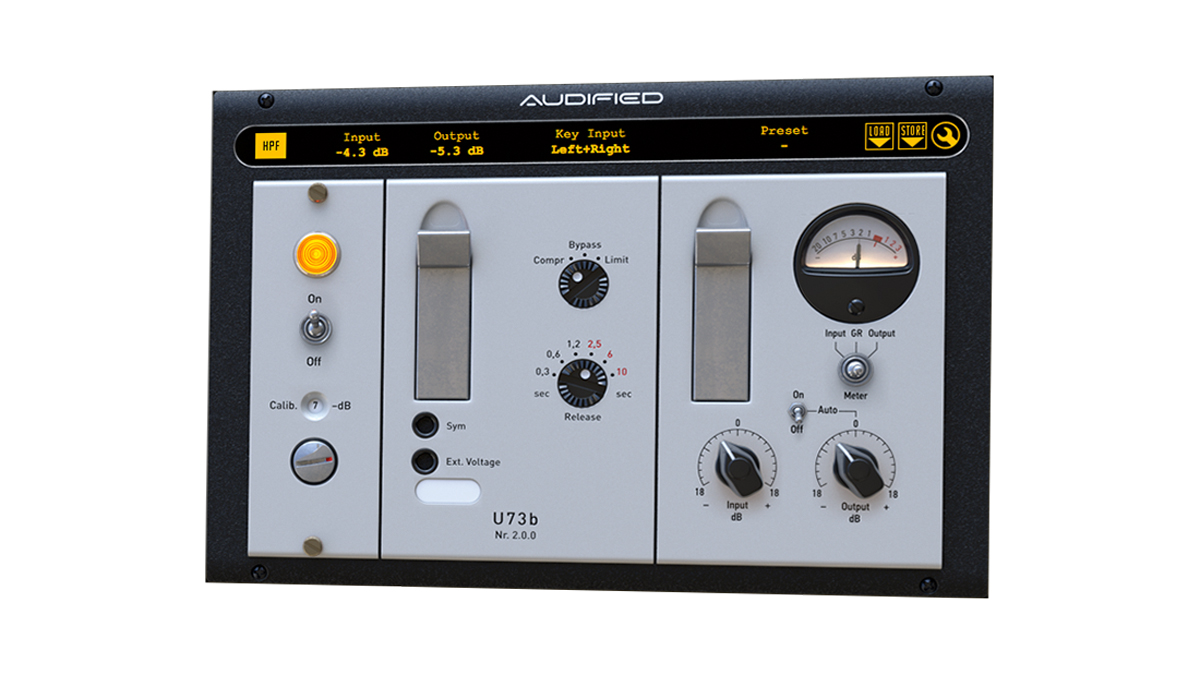MusicRadar Verdict
It may not be ideal for all compression duties, but the U73b has lots of character and has been excellently captured.
Pros
- +
Two distinct modes.
- +
High-pass filter bypass.
- +
Flexible stereo linking options.
Cons
- -
Curtailed high frequencies not suitable for all uses.
MusicRadar's got your back
A couple of years back, Audified released an emulation of Telefunken’s U73b valve compressor, and it’s now back with version 2 (AU, VST, VST3, AAX).
The U73b was a vari-mu style valve compressor/limiter, and despite being a little simpler than its US contemporaries - the Fairchild 660 and 670 - it had a character all its own. The plugin recreates said simplicity, giving you just four main controls: Input (threshold), Output, Release and a choice of operational modes: Compress, Limit or Bypass.
Further options include metering for Input, Output or Gain Reduction; operating level Calibration (0 to -24dB); and sidechain. New in version 2.0, there’s also Oversampling (On/Off), better-quality redesigned graphics, and interface settings for language (English/ German) and menu bar colour.
The original hardware U73b had a hardwired high-pass filter, which was included primarily to curtail unnecessary lows in program output. It was also pretty well suited to its common use as a final pre-lathe mastering compressor when cutting vinyl.
In practice, we think it’s pretty audible (Audified quotes 6dB/octave at 100Hz), and while we were checking it out in detail on the spectrum analyser, we also spotted some low-pass filtering at the upper end of the spectrum, starting above 10kHz. Thankfully Audified has included a manual bypass for the high-pass filter, which works in Compressor mode (in Limiter mode the filter is automatically bypassed), but the gentle curtailment of high frequencies is present when either Limiter or Compressor modes are selected, and is clearly part and parcel of the plugin’s retro design. Something to bear in mind if you’re processing full-frequency tracks or submixes and want to leave the high end untouched.
The sidechain includes both internal and external options, and with four internal stereo settings including summed (Left+Right) and completely independent (Individual), processing stereo signals is pretty flexible. The external option, which is new to version 2.0, is AU, VST3 and AAX only.
As ever with external sidechaining, you’ll need to check how your DAW handles this, as methods vary. Finally, U73b v2.0 also retains a couple of visual details based on the hardware (Sym and Ext. Voltage) that serve no purpose on the plugin, and this may be slightly confusing to new users.
Nothing compares to mu
Using valve biasing in gain reduction circuits creates some quite interesting behaviours, which U73b 2 captures well. In Compression mode, for example, the ratio gradually increases with level. Coupled with a low onset threshold with soft knee, we found some gentle glue-like behaviour at lower Input levels (good for mixes and submixes) giving way to more aggressive ratios at higher levels.
There’s also much interaction with the Release settings, which include three fixed timings (0.3, 0.6 and 1.2 secs), and three program-dependent settings. All told, the two controls can conjure a host of compression outcomes, most impressive on electric bass, which could be gently squashed, and snare drum, which benefited from a more aggressive, snappy attack effect.
The U73b also generates odd and even harmonics even at minimal gain reduction, adding presence and bringing sounds forward, and this is certainly part of its charm. In Limiter mode, the gain structure is different, and the Calibration setting provides a quick way to adjust levels if you’re switching between modes. The Limiter setting delivers a more sudden compression onset, making it trickier to handle but capable of aggressive effects.
In both modes, we found the U73b could respond surprisingly quickly, and this may in part be down to the feedforward compression topology it uses. Even so, at times it seemed quite transient-sensitive, making setting the levels tricky on some sound sources – and it has to be said, although the U73b can be excellent on some sounds, it can also be frustratingly unsuitable.
Overall, Audified has done a good job, successfully capturing the individuality of the original hardware. Nevertheless, that individuality makes this a secondary rather than primary processor.
Computer Music magazine is the world’s best selling publication dedicated solely to making great music with your Mac or PC computer. Each issue it brings its lucky readers the best in cutting-edge tutorials, need-to-know, expert software reviews and even all the tools you actually need to make great music today, courtesy of our legendary CM Plugin Suite.
“We were arguing a lot and we were miserable”: How Green Day exceeded expectations with their most ambitious song
"There’s plenty for us guitarists to learn – and ‘less is more’ is the overriding lesson": how to play like George Harrison on The Beatles' Abbey Road
“They didn’t like Prince’s bikini underwear”: Prince’s support sets for the The Rolling Stones in 1981 are remembered as disastrous, but guitarist Dez Dickerson says that the the crowd reaction wasn’t as bad as people think











